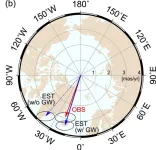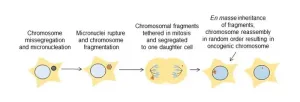(Press-News.org) PHILADELPHIA – Researchers from the Perelman School of Medicine at the University of Pennsylvania have invented a new way to map specific DNA markings called 5-methylcytosine (5mC) which regulate gene expression and have key roles in health and disease. The innovative technique allows for scientists to profile DNA using very small samples and without damaging the sample which means it can potentially be used in liquid biopsies (testing for cancer markers in the bloodstream) and early cancer detection. Additionally, unlike current methods, it also can clearly identify 5mC without confusing it with other common markings. The new approach, named Direct Methylation Sequencing (DM-Seq), is detailed in a Nature Chemical Biology article today.
Beyond the primary bases of DNA (adenine, cytosine, guanine, and thymine), there is an added layer of information in DNA modifications that control what genes are “on” or “off” in any given cell type. 5mC is considered to be one of the most important of these modifications, as it is the most common type of DNA modification in all mammals and is known for silencing certain genes.
“5mC can act as a fingerprint for cell identity, so it’s important for scientists to have the power to isolate 5mC and only 5mC,” said Rahul Kohli, MD, PhD, an associate professor of Biochemistry and Biophysics at Penn Medicine and a senior author of the study. “DM-Seq uses two enzymes to map 5mC and can be applied to sparse DNA samples which means it could be used, for example, in blood tests that look for DNA released into the blood from tumors or other diseases tissues.” The study was led by Tong Wang, an MD/PhD student in Kohli’s lab.
DNA modifications such as 5mC function as epigenetic (reversible, environmentally-caused) regulators that alter how DNA is read. 5mC involves the attachment of a small cluster of atoms called a methyl group at a particular site on a cytosine, also known as the letter “C” in the four-letter DNA alphabet. The presence of this modification can impede the expression of nearby DNA through direct and indirect mechanisms.
The DNA that is rendered inactive by 5mC includes protein-encoding genes whose activity may not be appropriate in a given cell type at a given stage of life, as well as virus-like elements in DNA that should always be suppressed. Unsurprisingly, the abnormal absence or excess of 5mC can lead to abnormal gene expression, which can drive diseases such as cancers. Certain abnormal patterns of 5mCs are considered signatures of some cancers—which underscores the importance of having an accurate and specific 5mC mapping method.
Methods for mapping 5mC use chemicals or enzymes that react with 5mC and normal unmodified cytosine in different ways, allowing the two to be distinguished. But the traditional method, bisulfite sequencing (BS-Seq), is significantly damaging to DNA, and fails to distinguish between 5mC and another important type of methylation called 5-hydroxymethylcytosine (5hmC). More recently developed methods also have shortcomings including the requirement for relatively large amounts of DNA.
DM-Seq utilizes two enzymes that can modify DNA, a designer DNA methyltransferase and a DNA deaminase, which together can detect 5mC directly and specifically. It also is sensitive enough to be done with nanogram amounts of DNA, which makes it suitable for liquid biopsy applications.
The researchers performed DM-Seq on glioblastoma-type brain tumor samples and demonstrated that, in comparison with traditional BS-Seq, DM-Seq was better able to distinguish 5mC from 5hmC at key sites on the genome where methylation levels can be used to predict patient outcomes.
The researchers also compared DM-Seq to another new, emerging 5mC-sequencing technique called TAPS, which is being explored for potential applications in cancer diagnostics, showing that the latter has a previously undiscovered drawback that reduces its 5mC-detection sensitivity.
“These findings highlight ways in which direct detection of 5mC from DM-Seq, rather than traditional sequencing methods, could advance efforts to use epigenetic sequencing for prognostic purposes in cancer care,” Kohli said.
Along with Kohli and Wang, other Penn authors included Johanna Fowler, Laura Liu, Christian Loo, Meiqi Luo, Emily Schutsky, Kiara Berríos, Jamie DeNizio, Saira Montermoso, Bianca Pingul, MacLean Nasrallah, and Hao Wu.
The research was supported by the National Institutes of Health (R01-HG10646).
Penn Medicine is one of the world’s leading academic medical centers, dedicated to the related missions of medical education, biomedical research, and excellence in patient care. Penn Medicine consists of the Raymond and Ruth Perelman School of Medicine at the University of Pennsylvania (founded in 1765 as the nation’s first medical school) and the University of Pennsylvania Health System, which together form a $9.9 billion enterprise.
The Perelman School of Medicine has been ranked among the top medical schools in the United States for more than 20 years, according to U.S. News & World Report's survey of research-oriented medical schools. The School is consistently among the nation's top recipients of funding from the National Institutes of Health, with $546 million awarded in the 2021 fiscal year.
The University of Pennsylvania Health System’s patient care facilities include: the Hospital of the University of Pennsylvania and Penn Presbyterian Medical Center—which are recognized as one of the nation’s top “Honor Roll” hospitals by U.S. News & World Report—Chester County Hospital; Lancaster General Health; Penn Medicine Princeton Health; and Pennsylvania Hospital, the nation’s first hospital, founded in 1751. Additional facilities and enterprises include Good Shepherd Penn Partners, Penn Medicine at Home, Lancaster Behavioral Health Hospital, and Princeton House Behavioral Health, among others.
Penn Medicine is powered by a talented and dedicated workforce of more than 47,000 people. The organization also has alliances with top community health systems across both Southeastern Pennsylvania and Southern New Jersey, creating more options for patients no matter where they live.
Penn Medicine is committed to improving lives and health through a variety of community-based programs and activities. In fiscal year 2021, Penn Medicine provided more than $619 million to benefit our community.
END
New, precise, and efficient DNA sequencing method may lead to easier testing and earlier cancer detection
The technique, created by Penn Medicine researchers, requires smaller DNA samples for testing and opens up potential new opportunities for next-generation diagnostics.
2023-06-15
ELSE PRESS RELEASES FROM THIS DATE:
We’ve pumped so much groundwater that we’ve nudged the Earth’s spin
2023-06-15
American Geophysical Union
15 June 2023
Release No. 23-25
For Immediate Release
This press release is available online at: https://news.agu.org/press-release/weve-pumped-so-much-groundwater-that-weve-nudged-the-earths-spin
AGU press contact:
Rebecca Dzombak, news@agu.org (UTC-4 hours)
Contact information for the researchers:
Ki-Weon Seo, Seoul National University, seokiweon@snu.ac.kr (UTC+9 hours)
WASHINGTON — By pumping water out of the ground and moving it elsewhere, humans have shifted such a large mass of water that the Earth tilted nearly 80 centimeters (31.5 inches) east between 1993 and 2010 alone, according to a new study published in Geophysical Research Letters, ...
Body image concerns significantly higher in women living with PCOS
2023-06-15
Women living with polycystic ovary syndrome (PCOS) experience greater body image concerns than individuals without the condition, according to research being presented Saturday at ENDO 2023, the Endocrine Society’s annual meeting in Chicago, Ill.
PCOS affects 7% to 10% of women and is the most common cause of infertility. It is also linked to metabolic health problems such as diabetes, cardiovascular health conditions, and mental health conditions including depression and anxiety.
“Although PCOS, depression and anxiety have a substantial correlation, ...
Women with polycystic ovary syndrome may face increased risk of death
2023-06-15
People with polycystic ovary syndrome (PCOS) have a 47% increased risk for death at a younger age compared with those without the condition, according to research being presented on Sunday at ENDO 2023, the Endocrine Society’s annual meeting in Chicago, Ill.
PCOS is a common cause of infertility in women, and it occurs in 7% to 10% of women of reproductive age. Women with PCOS may have higher than normal levels of testosterone and other reproductive hormones called androgens, irregular periods, and/or cysts on the ovaries. The condition raises the risk of developing diabetes and cardiovascular conditions.
“The results highlight the need ...
Fungal infections an unintended consequence of advanced immunotherapy, research shows
2023-06-15
Major fungal infections have become more common across the globe, and one unexpected phenomenon among the rise of fungi is life-threatening infections as a result of a complication of certain immunotherapies and small molecule kinase inhibitors.
A scientist at the Hackensack Meridian Center for Discovery and Innovation (CDI) has identified the specific mechanistic cause of one such phenomenon, which will likely save lives into the future, via a new publication.
The paper “C5a-licensed phagocytes drive sterilizing immunity during systemic fungal infection” appeared in the journal Cell ...
How microgrids can help communities adapt to wildfires
2023-06-15
– By Dan Mullen
Wildfires have become increasingly frequent due to climate change, with record occurrences in areas not historically prone to them. In California, wildfires and regional power shutoffs have cost billions and taken lives. For some 46 million Americans living next to forests – at what scientists call the “wildland-urban interface” (WUI) – the risks of wildfire can be especially acute.
Microgrids can build resilience in vulnerable communities. By using small-scale, local energy sources and disconnecting from regional grids during emergencies, they can deliver essential services to keep homes and communities ...
Quantum interference of light : an anomalous phenomenon found
2023-06-15
In a paper published in Nature Photonics, the research team from the Center for Quantum Information and Communication – Ecole polytechnique de Bruxelles of Université libre de Bruxelles, has found an unexpected counter-example to common knowledge on photon bunching.
One of the cornerstones of quantum physics is Niels Bohr's complementarity principle, roughly speaking the fact that objects may behave either like particles or like waves. These two mutually exclusive descriptions are well illustrated in the iconic double-slit experiment, ...
New biotech venture PHIOGEN, a spinoff of BCM’s TAILOR Labs, to tackle the global threat of antimicrobial resistance
2023-06-15
The new biotech venture PHIOGEN is a spin-off company from Baylor College of Medicine’s TAILOR Labs, one of the United States only academic phage therapy cores with a decade’s worth of revolutionary research related to bacteriophages, viruses that infect and destroy bacteria.
The company made its debut at the 6th World Conference on Targeting Phage Therapy in Paris, June 1-2, 2023.
PHIOGEN’s R&D efforts are led by phage researcher Dr. Anthony ...
How will a warming world impact the Earth’s ability to offset our carbon emissions?
2023-06-15
Washington, DC—As the world heats up due to climate change, how much can we continue to depend on plants and soils to help alleviate some of our self-inflicted damage by removing carbon pollution from the atmosphere?
New work led by Carnegie’s Wu Sun and Anna Michalak tackles this key question by deploying a bold new approach for inferring the temperature sensitivity of ecosystem respiration—which represents one side of the equation balancing carbon dioxide uptake and carbon dioxide output in terrestrial environments. Their findings are published in Nature Ecology & Evolution.
“Right now, plants in the terrestrial ...
New research shows the benefits of teaching pupils about mental health in the classroom
2023-06-15
Giving schools the right resources and training to teach pupils about mental health really can have a positive impact on young people’s wellbeing.
New research by Welsh academics has just been published demonstrating the benefits of improving pupils’ mental health literacy and reducing the stigma around mental health issues at a crucial stage in a young person’s life.
Most mental health problems start in the teenage years with a recent survey identifying that two in five young people report mental health symptoms. However, due to poor knowledge ...
Tethering of shattered chromosomal fragments paves way for new cancer therapies
2023-06-15
Healthy cells work hard to maintain the integrity of our DNA, but occasionally, a chromosome can get separated from the others and break apart during cell division. The tiny fragments of DNA then get reassembled in random order in the new cell, sometimes producing cancerous gene mutations.
This chromosomal shattering and rearranging is called “chromothripsis” and occurs in the majority of human cancers, especially cancers of the bones, brain and fatty tissue. Chromothripsis was first ...
LAST 30 PRESS RELEASES:
Pure bred: New stem cell medium only has canine components
Largest study of its kind highlights benefits – and risks – of plant-based diets in children
Synergistic effects of single-crystal HfB2 nanorods: Simultaneous enhancement of mechanical properties and ablation resistance
Mysterious X-ray variability of the strongly magnetized neutron star NGC 7793 P13
The key to increasing patients’ advance care medical planning may be automatic patient outreach
Palaeontology: Ancient tooth suggests ocean predator could hunt in rivers
Polar bears may be adapting to survive warmer climates, says study
Canadian wildfire smoke worsened pediatric asthma in US Northeast: UVM study
New UBCO research challenges traditional teen suicide prevention models
Diversity language in US medical research agency grants declined 25% since 2024
Concern over growing use of AI chatbots to stave off loneliness
Biomedical authors often call a reference “recent” — even when it is decades old, analysis shows
The Lancet: New single dose oral treatment for gonorrhoea effectively combats drug-resistant infections, trial finds
Proton therapy shows survival benefit in Phase III trial for patients with head and neck cancers
Blood test reveals prognosis after cardiac arrest
UBCO study finds microdosing can temporarily improve mood, creativity
An ECOG-ACRIN imaging study solves a long-standing gap in metastatic breast cancer research and care: accurately measuring treatment response in patients with bone metastases
Cleveland Clinic presents final results of phase 1 clinical trial of preventive breast cancer vaccine study
Nationally renowned anesthesiology physician-scientist and clinical operations leader David Mintz, MD, PhD, named Chair of the Department of Anesthesiology at the UM School of Medicine
Clean water access improves child health in Mozambique, study shows
Study implicates enzyme in neurodegenerative conditions
Tufts professor named Fellow of the National Academy of Inventors
Tiny new device could enable giant future quantum computers
Tracing a path through photosynthesis to food security
First patient in Arizona treated with new immune-cell therapy at HonorHealth Research Institute
Studies investigate how AI can aid clinicians in analyzing medical images
Researchers pitch strategies to identify potential fraudulent participants in online qualitative research
Sweeping study shows similar genetic factors underlie multiple psychiatric disorders
How extreme weather events affect agricultural trade between US states
Smallholder farms maintain strong pollinator diversity – even when far from forests
[Press-News.org] New, precise, and efficient DNA sequencing method may lead to easier testing and earlier cancer detectionThe technique, created by Penn Medicine researchers, requires smaller DNA samples for testing and opens up potential new opportunities for next-generation diagnostics.





